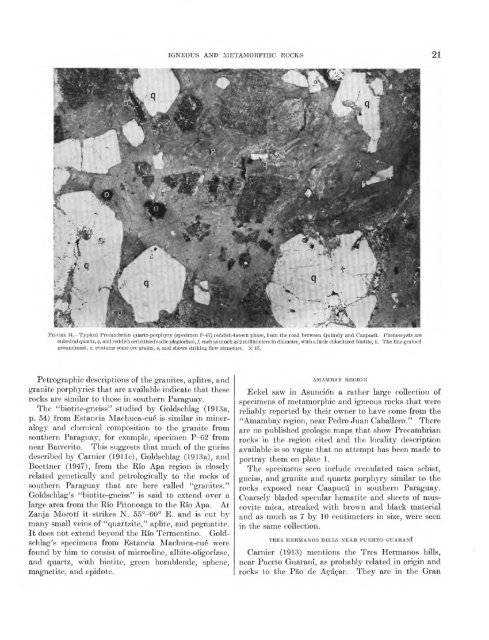Geology and Mineral Resources of Paraguay A Reconnaissance
Geology and Mineral Resources of Paraguay A Reconnaissance
Geology and Mineral Resources of Paraguay A Reconnaissance
- No tags were found...
Create successful ePaper yourself
Turn your PDF publications into a flip-book with our unique Google optimized e-Paper software.
IGNEOUS AND METAMORPHIC ROCKS 21FIGURE 14. Typical Precambrian quartz-porphyry (specimen P-67) reddish-brown phase, from the road between Quiindy <strong>and</strong> Caapucu. Phenocrysts areeuhedral quartz, q, <strong>and</strong> reddish sericitized sodic plagioclase, /, each as much as 2 millimeters in diameter, with a little chloritized biotite, b. The fine-grainedgroundmass, g, contains some ore grains, o, <strong>and</strong> shows striking flow structure. X 15.Petrographic descriptions <strong>of</strong> the granites, aplites, <strong>and</strong>granite porphyries that are available indicate that theserocks are similar to those in southern <strong>Paraguay</strong>.The "biotite-gneiss" studied by Goldschlag (1913a,p. 54) from Estancia Machuca-cue is similar in mineralogy<strong>and</strong> chemical composition to the granite fromsouthern <strong>Paraguay</strong>, for example, specimen P-62 fromnear Barrerito. This suggests that much <strong>of</strong> the gneissdescribed by Carnier (IQllc), Goldschlag (1913a), <strong>and</strong>Boettner (1947), from the Rio Apa region is closelyrelated genetically <strong>and</strong> petrologically to the rocks <strong>of</strong>southern <strong>Paraguay</strong> that are here called "granites."Goldschlag's "biotite-gneiss" is said to extend over alarge area from the Rio Pitonoaga to the Rio Apa. AtZanja Moroti it strikes N. 55°-60° E. <strong>and</strong> is cut bymany small veins <strong>of</strong> "quartzite," aplite, <strong>and</strong> pegmatite.It does not extend beyond the Rio Termentino. Goldschlag'sspecimens from Estancia Machuca-cue werefound by him to consist <strong>of</strong> microcline, albite-oligoclase,<strong>and</strong> quartz, with biotite, green hornblende, sphene,magnetite, <strong>and</strong> epidote.AMAMBAY REGIONEckel saw in Asuncion a rather large collection <strong>of</strong>specimens <strong>of</strong> metamorphic <strong>and</strong> igneous rocks that werereliably reported by their owner to have come from the"Amambay region, near Pedro Juan Caballero." Thereare no published geologic maps that show Precambrianrocks in the region cited <strong>and</strong> the locality descriptionavailable is so vague that no attempt has been made toportray them on plate 1.The specimens seen include crenulated mica schist,gneiss, <strong>and</strong> granite <strong>and</strong> quartz porphyry similar to therocks exposed near Caapucu in southern <strong>Paraguay</strong>.Coarsely bladed specular hematite <strong>and</strong> sheets <strong>of</strong> muscovitemica, streaked with brown <strong>and</strong> black material<strong>and</strong> as much as 7 by 10 centimeters in size, were seenin the same collection.TRES HERMAN OS HILLS NEAR PUERTO GTJARANfCarnier (1913) mentions the Tres Hermanos hills,near Puerto Guarani, as probably related in origin <strong>and</strong>rocks to the Pao de Acucar. They are in the Gran
















